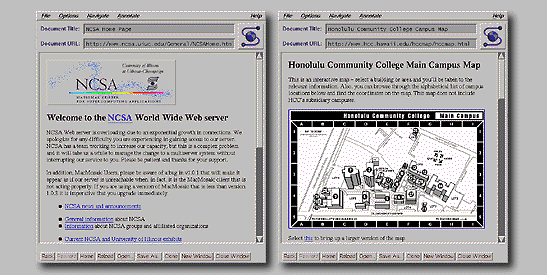
![[Back]](graphics/btn.back.gif)
![[Contents]](graphics/btn.contents.gif)
![[Next]](graphics/btn.next.gif)

Months after CERN's original proposal, the National Center for Supercomputing Applications (NCSA) began a project to create an interface to the World-Wide Web. One of NCSA's missions is to aid the scientific research community by producing widely available, non-commercial software. Another of its goals is to investigate new research technologies in the hope that commercial interests will be able to profit from them. In these ways, the Web project was quite appropriate. The NCSA's Software Design Group began work on a versatile, multi-platform interface to the World-Wide Web, and called it Mosaic.
In the first half of 1993, the first version of NCSA's Web browser was made available to the Internet community. Because earlier beta versions were distributed, Mosaic had developed a strong following by the time it was officially released. Because it allowed documents with images to be viewed and new media formats such as video and sound to be transferred over the Internet and pointed to by documents, it became the Web browser of choice for those working on computers with graphics capability. In 1993 NCSA's Mosaic products won the Internet Multicasting Service's yearly Ima award for the Most Innovative Application and the InfoWorld Industry Achievement award.
Because of the number of traditional services it could handle, and due to its easy, point-and-click hypermedia interface, Mosaic soon became the most popular interface to the Web. Currently versions of Mosaic can run on UNIX-based machines such as Sun, Silicon Graphics, and DEC workstations as well as IBM-compatibles running Microsoft Windows and Macintosh computers.

Figure 5. NCSA's Mosaic for X Windows.